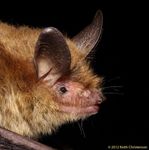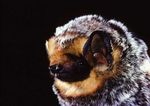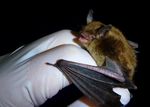Washington, D.C. Bat Species List - DOEE.DC.Gov.
←
→
Page content transcription
If your browser does not render page correctly, please read the page content below
Washington, D.C. Bat Species List
Washington D.C.’s bats are divided into two main groups based on their roosting habits- “cave bats” and
“tree bats.” “Cave bats” hibernate in caves during the winter and usually form colonies to roost and
raise their pups during the summer. These colonies can be found in tree cavities, buildings, or other
human-made structures. “Tree bats” tend to be solitary and roost under pieces of bark or in small
groups. Tree bats often forage in the upper forest canopy and migrate long distances during the spring
and fall.
Washington, D.C.’s Cave Bats
Big Brown Bat (Eptesicus fuscus)
Big brown bats are ubiquitous throughout the
United States and are found in both cities and
rural environments. They usually form maternity
colonies under loose bark and within small tree
cavities. Other maternity roosts are commonly
found in buildings and barns and under bridges.
Big brown bats are a highly adaptable bat
species that can relocate to human-made
structures in response to increasing levels of
habitat loss. They can also tolerate cooler (Photo Credit: Paul and Joyce Berquist)
temperatures than other bat species, allowing them to roost in
less insulated structures. Big brown bats are insectivorous and are specialized to prey upon beetles, but
they will also consume other insects such as moths, ants, wasps, and flies. In Washington, D.C., big
brown bats are one of the more likely species to form a colony inside of a home and are commonly
observed foraging at dusk.
Little Brown Bat (Myotis lucifugus)
White-Nose Syndrome has decimated populations of little brown bats in Washington, D.C., and they are
expected to become extirpated within the next few decades. Where they remain, little brown bats often
form large summer maternity colonies in buildings
(Photo Credit: SM Bishop)
containing hundreds to thousands of individuals.
During the winter, many hibernate in caves in large
colonies. Little brown bats produce only one pup
each year. They forage on aquatic insects, such as
mosquitoes, flies, and beetles, and typically feed on
swarms to save time and energy while searching for
food. Little brown bats often consume half of their
body weight while foraging at night. Despite their
small size (less than a half ounce!), they have been
documented to live up to 34 years.
Updated: July 2018Tri-colored Bat (Perimyotis subflavus)
The tri-colored bat, formerly known as the Eastern Pipistrelle,
is characterized by the presence of three colors on their
individual hairs. The hair base and tip are dark, and the middle
is yellow-brown. Tri-colored bats emerge early to forage at
dusk and feed on a variety of insects. They begin hibernation
early in the fall and are late to emerge in the spring. They
hibernate in sites deep within caves and mines where
temperatures are more stable, and tri-colored bats return to
these sites each year. Little is known about their roosting
habits and parental behavior, but they have been observed to
hibernate individually or in small groups of 2 or 3.
(Photo Credit: Brian Lee Cooper)
Northern Long-eared Bat (Myotis septentrionalis)
The northern long-eared bat has experienced huge
population declines due to White-Nose Syndrome and
was recently listed as federally threatened under the
Endangered Species Act. They have characteristic long
ears that when folded forward extend past the tip of
their nose. Northern long-eared bats often live in
dense forests and use peeling bark and tree cavities for
maternity roosts. They hibernate in caves and
underground mines, where they typically use cooler
areas in the cave than tri-colored and little brown bats.
Northern long-eared bats are usually solitary and
hibernate alone or in very small groups. Little is known
about their specific food preferences; however, they
are often observed foraging early after dusk for insects
over streams and in forest clearings.
(Photo Credit: Keith Christenson)
Updated: July 2018Washington, D.C.’s Tree Bats
Eastern Red Bat (Lasiurus borealis)
Eastern red bats are Washington, D.C.’s most abundant “tree bat.” Their pelage color ranges from a
deep red to a yellow-red,
and males tend to be
redder than females. The
tips of their hairs are white,
giving them a frosted
appearance. They roost
solitarily on low tree
branches, camouflaged like
a leaf as they hang partially
wrapped in their furry tail
membrane. Eastern red
bats often give birth to
twins and can have litters of
up to five pups. They are
among the earliest bats to
emerge at dusk and
typically forage on insects around forest edges, in clearings, or around (Photo Credit: Merlin Tuttle)
streetlights where they consume mostly moths. They migrate in the fall along the same migratory
pathways as many birds to warmer climates, and very little is known about their winter roosting
behavior. However, they have been documented to hibernate in leaf litter on the ground. Like other
migrating bat species, eastern red bats appear to remain unaffected by White-Nose Syndrome.
Hoary Bat (Lasiurus cinereus)
Hoary bats are the largest bat species in
Washington, D.C. They have dense, white-
tipped silky fur, creating a frosted
(“hoary”) appearance. They are rarely
seen by humans, as they aren’t attracted
to manmade structures and stay well-
hidden in foliage throughout the day. They
wait until after dark to emerge and forage,
and peak activity tends to occur about five
hours after sunset. Hoary bats are
insectivorous and prey primarily on moths.
Though hoary bats roost solitarily, they
sometimes migrate south in groups
(Photo Credit: Merlin Tuttle) during the late summer and early fall.
Updated: July 2018Silver-haired Bat (Lasionycteris noctivagans)
Silver-haired bats possess silver-tipped hairs
running down their back and have a slightly
upturned nose. They are an elusive species that
prefers to roost in forests near bodies of water.
They often roost under peeling bark and will form
maternity colonies in tree cavities or small
hollows. They will also occasionally roost in wood
piles, on cliff faces, and in cave entrances. Silver-
haired bats tend to forage early in the evening
and again before sunrise, perhaps to avoid
competition with other faster-flying species
throughout the night. Silver-haired bats prey upon
a large range of agricultural and human pest insects, including moths, (Photo Credit: John MacGregor)
flies, and beetles.
Evening Bat (Nycticeius humeralis)
Evening bats are dark brown in coloration and
are distinguished from other small bats by their
hairless, broad, dark snout. Though they may
resemble other Myotis species, they may be
distinguished by their curved tragus. Evening
bats are social and roost in small colonies. They
roost in tree hollows, under peeling bark, and
inside buildings, and they migrate south in the
fall.
(Photo Credit: David Arbour)
Bats of Unknown Status in Washington, D.C.
Eastern Small-footed Bat (Myotis leibii)
Indiana Bat (Myotis sodalis)
Updated: July 2018You can also read

























































